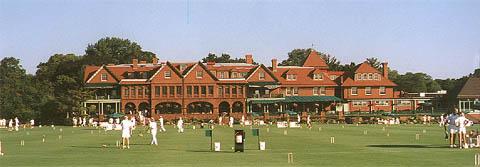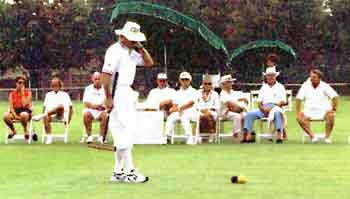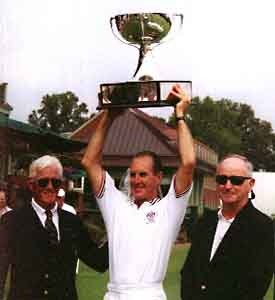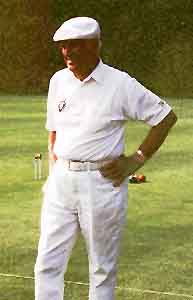

|
Back to |
| The Front Page |
| Archives |

|
1998 American Rules Nationals
at Merion breaks new ground
--based on reports of Jim Armour and Harold Menzel, photos by Frank Borden, Cindy Gowell, and Harold Menzel, edited by Bob Alman Posted November 1, 1998 |
|
||||||||||
The 1998 USCA American Rules National Championship lived up to its advance billing as the biggest ever. Registered in three flights of singles and doubles were 116 players. With 17 courts all in the same place - on the Great Lawn of the Merion Cricket Club in Haverford, Pennsylvania - the event presented the kind of spectacle seldom seen in the relatively small sport.

|
| Merion Cricket Club - Haverford, Pennsylvania - site of the 1998 USCA American Rules National Championships. |
In one of the largest championship flights in the 20-year history of the event, 52 players competed. (Three others were knocked out for various reasons, including President Dan Mahoney, whose travel plans were hampered by mudslides near his Idaho summer digs.) The sheer number of courts allowed plenty of opportunity for lots of games in all flights. All second and third flight players of both singles and doubles were scheduled for games through Saturday, the sixth day of the seven-day touranment.
The starting 52 players in the Championship Flight were brought down to 30 via block play, and then a second round of block play brought the field down to the final sixteen, who played out a double-elimination draw.
Championship game was 15th straight win for Mik Mehas
Michael (Mik) Mehas, the Championship Singles winner, played 15 singles matches during the week without a loss. Mik dedicated his win in the finals to Woodruff Leeming of New Canaan, Connecticut, a long-time stalwart of the Greenwich Croquet Club and "as good a friend as a person could have," in the words of Mehas.
The contestants for the 1998 USCA Championship were Paul Scott from Charlotte, North Carolina, and Michael (Mik) Mehas from Palm Springs, California. Mehas, with a -0.5 handicap, is a long-time veteran of the top ranks of American rules croquet, while Paul Scott, handicapped at +.5, was playing in his first Nationals. Scott's style of play, conditioned by International Rules play in his native England, emphasizes carefully controlled shotmaking.
Mehas is a colorful player, who with his stylish plus-fours and his strong shooting, stands out on any croquet lawn. Mehas has contested the Nationals many times, coming in as high as third place on two occasions. He has captured most of the other top titles in American croquet, including the national doubles title. He now holds both the International Rules and the American Rules national championships (a feat matched in the past only by Damon Bidencope in 1989 and Mac Penwell in 1993/94). He won the plate in the British Open this year and travelled to Leamington Spa in early October to compete in the third annual Golf Croquet World Championship. He plans to defend his International Rules title in Palm Beach later in the month. All this makes him the most active top American competitor in the sport.
His dress, his style, his confidence - which some mark as arrogance - cannot fail to draw the attention of the crowd and much comment, both favorable and unfavorable. He carries his history in the sport with him, a history that has been marked by controversy and even official censure. But he's riding a crest now of victory upon victory. It hardly matters that some of them are very close indeed, and that to some, he seems an unreasonably lucky player.
The final match played on "center court" of the spectacular Great Lawn of the Merion Cricket Club, won by a narrow margin, was no exception. A running commentary was provided by Tournament Director Ted Prentis, while Mehas and Scott supplied the drama. Mehas played blue/black; Scott, red/yellow.
Characteristically, Mehas started by keeping one of his balls out. (See his CROQUET WORLD article on the balls-out game.)

|
| Mik Mehas contemplates a shot in the championship match. |
This gave black an opportunity to enter the game with a 3-ball break, and Mehas ran it to 3-back before breaking down.
Yellow took a long shot at blue but missed, bouncing off #1 wicket, and now blue had a three-ball break opportunity. But to his and the spectators' surprise, Mehas stuffed #3 wicket on a fairly easy shot.
Red, behind #2 wicket and not in the game, shot back up towards #1 to get into position, but hit the #2 wicket! Not good! Black shot out, and yellow was left with a difficult shot at blue, lying against #3 wicket. Scott made the shot and ran two balls to #5, then hit yellow out.
Mehas was able to pick up a couple of wickets while Scott was maneuvering red into position at #1 wicket. Paul finally got the ball to the wicket, and with blue and black behind #1 wicket in the blue corner, shot the wicket. Scott then attempted a roquet at blue/black but came up short. Mehas, preparing for the three-ball break, shot black towards its next wicket, anticipating that blue would roquet red and be on its way.
But Scott then made the shot of the day. With blue in the blue corner, and with yellow in the yellow corner, Paul shot yellow across the court and just nicked blue! Moments before, Mik had the game put away, and now Paul - with a miracle hit-in - had created a four-ball break opportunity. He ran the break faultlessly, bringing yellow through rover, and leaving the balls in a difficult position for blue to roquet. Rather than try for it, blue sensibly hit out in the blue corner.
Scott was now in control of the game. Red had a three-ball break, starting at #2 wicket, and Scott ran it through 1-back. The ball only just cleared the wicket, leaving a problematic, but not difficult, roquet shot at yellow. Missed!
Black, down by #4 Wicket, hit up towards red but missed, and both players then took their balls to the sidelines.

|
| The champion rejoices between Archie Peck and Jim Hughes. |
Yellow (rover) had an angle shot at the wicket, and being three-ball dead was clearly tempted to give it a try. Scott eyed the situation studiously, then chose to shoot out.
The game was now winding down. The wicket count was 20 to 18 in favor of Scott, but the field setup seemed to favor Mehas. Yellow was near the peg, with black stuffed in the rover wicket. Scott studied the situation for a while, then walked towards the red ball near the black corner. The 15-second call came from Bob Kroeger, keeping the shot clock. By the time Paul realized (actually, was told) that it was yellow to play, it was too late. The shot clock time was called on the backswing, and yellow stayed in the middle of the court.
That was the game. After a desperation shot by red, black ran rover, collected red, pegged out yellow, and set up the 3-ball break for blue, near 1-back. At this point, the wicket count was 21 for red- yellow and 18 for blue-black. With yellow out of the game, it was now blue's turn. In last turn with blue, Mik ran the break around to Penultimate, giving him 23 total wickets.
With the two-point lead, Mehas then put both balls out of bounds. Scott attempted another miracle hit-in, but it was not to be. Red just missed blue, and the game was over. Mik Mehas had won his first American Rules national championship.
Championship Flight Doubles is typically low-key

|
| Rich Curtis and Doug Grimsley confer. |
The tone of the game was careful and conservative. They were playing on the court that would be used for the championship singles in a couple of hours, and the wickets had been set on the tight side, which perhaps bothered them a bit. At any rate, there was hardly any attacking until very late in the game, and no long break until the game was nearly over. The players seemed content to run a wicket or two and then shoot out.
In the end, the timing was all on the side of the Curtis/Grismley team, who claimed the national doubles championship.
Youth wins in First Flight Singles
The winner, Frank Hentic, of Southampton, New York, at age 16, was the youngest player in the event. Frank had a good tournament, coming in third in the doubles with his father, Yves. The young Hentic defeated Garnett Turner, patriarch of the remarkable Turner family of Virginia and father of Ronald and Darrell Turner, runners-up in Championship Doubles.
Last-ball turn-around attempt in First Flight Doubles falls short.
The match was contested by Gray Wyatt and Freeman Turley, both from Richmond, Virginia; and Travis Watson, Basye, Virginia, playing with Garnett Turner. Wyatt-Turley played blue-black, Watson-Turner played red-yellow. Wyatt ran blue early to 2-back. There was a fair amount of sideline temporizing, as the players tried to set advantageous positions. Black eventually reached #5 wicket, and stuffed it. Red then got a 4-ball break and ran to penultimate. Towards the end of the game, black ran to rover. Black was first ball in last turn with the score 20 - 18 in favor of Wyatt-Turley. Red was in position at penultimate with a long shot. Black and blue were on the West boundary relatively close to each other. Black attempted a short roquet on blue in order to take red out of position and missed the roquet. Yellow came out on the court near the rover wicket for red to use. Blue was dead on black and stayed on the boundary. Red made penultimate, but rolled up to the peg and had no shot on yellow and was unable to make another roquet. The final score was 20 - 19.
Second Flight Singles taken by Dilley of Michigan

|
| Al Dilley in his sartorial splendor. |
In the second flight singles final between Al Dilley, of Grand Rapids, Michigan, and Graham McCauley, from Versailles, Kentucky, Al, playing blue-black,got off to an early lead, and brought both balls to #4 wicket. Red had trouble at #3, and was stuck there for what must have seemed like an eternity to Graham.
Dilley continued to play conservatively - his style throughout the tournament - and 2-balled blue-black to 2-back, shot the wicket with blue, and set up black. McCauley, now far behind with only six total wickets, attacked with red and broke up the set-up, but could gain no more than a single wicket. Dilley went on to win, 21-15.
At the awards ceremony. Al expressed his thanks to fellow Michigander Joe Koenig, from Ypsilanti (who had a fairly successful tournament himself, making the final draw in the championship flight) for being his teacher and guru.
Third Flight Singles is a deadness contest

|
| Ted Kemp and Harold Menzel begin their final match. |
Eastern regional players dominated tourney
The great majority of the players were from the Eastern seaboard. But there were eight from "middle America"; six from the Southwest, and three from the West coast. The international contingent included a player from Quebec, one from Mexico, and two from Bermuda (John and Nelga Young, veterans of the early days of USCA championship play).
The strong eight-person Virginia contingent was led by the Turners of Fulks run, who kept popping up all over the draw and in finals matches.
The Peyton Ballenger Trophy for the woman player with the best result in Championship Singles went to Terri Spoonhour of Orlando, Florida, and was presented by Jackie Jones, a two-time winner of the trophy.

|
| Terri Spoonhour receives the Peyton Ballenger trophy from Jackie Jones. |
There is no question that the players appreciated having the tournament at one location. Despite some scheduling glitches, the one-venue nationals worked so well that speculation has already begun about repeating in 1999. Merion and Southampton appear to be the only locales at present which could put together the required number of courts. Rumor has it that Southampton is a good possibility for 1999. One of the biggest complaints around the tournament was the too-tight scheduling of games, with only ten minutes between matches - not sufficient time to allow for last-turn play and other normal delays. A shortage of referees was noted by some players. Both these flaws are easily corrected. All the review are in: the 1998 nationals at Merion were a big hit. The games worked well, and the most important factors in any tournament - the weather and the food - were exceptional. There was plenty of sun every day, the only rain falling during one overnight. The lunches provided by The Merion Cricket Club drew raves. Some of the players were disappointed with the continental breakfasts. The players seemed to thoroughly enjoy the facilities, the Lawn, and the week of croquet
Complete 1998 Nationals Results
CHAMPIONSHIP SINGLES CHAMPIONSHIP DOUBLES 1. MICHAEL MEHAS 1. DOUG GRIMSLEY - RICH CURTIS 2. PAUL SCOTT 2. DARREL TURNER - RON TURNER 3. JOHN OSBORN 3. JOHN CURINGTON - WAYNE SYNAN JEFF SOO 4. BOB CHERRY - GAR BECKSTEAD 5. DARREL TURNER 5. JIM HUGHES - BOB KROEGER BILL BERNE LARRY MOORE - PHIL PARKER 7. JAY HUGHES 9. JOHN OSBORN - MICHAEL MEHAS JOE KOENIG CARL UHLMAN - RICK SHEELY 9. DAVID MALOOF MACK PENWELL - JEFF SOO WAYNE SYNAN MATT GRIFFITH - RON LLOYD NEIL HOUGHTON NEIL HOUGHTON - BILL MARTIN BOB KROEGER BRITT RUBY - JOE YODER 13. FRED JONES DIGBY BRIDGES - ARCHIE PECK JIM HOUSER 15. JOE KOENIG - JOHNNY MITCHELL GAR BECKSTEAD BILL BERNE - BILLIE JEAN BERNE RON TURNER PAUL BENNETT - JOHN DILL 17. JOHN OEHRLE RUFUS BAYARD - TOM COOPER MACK PENWELL JOHN OEHRLE - WOODY LEEMING BOB CHERRY JOHN YOUNG - JIM HOUSER DICK BRACKETT JIM SPOONHOUR - KEN SCOGGINS KEN SCOGGINS 22. DERRICK ROBINSON - JEREMY EVANS 22. JIM SPOONHOUR DAVID MALOOF - TERRI SPOONHOUR 23. JOHN CURINGTON FRED JONES - JACKIE JONES RICK SHEELY 25. DICK BRACKETT - STUART LAWRENCE DOUG GRIMSLEY LILA BAITSCHOVA - AUSTIN CONNELLEY TERRI SPOONHOUR TOM COOPER STUART LAWRENCE 29. BRITT RUBY JACKIE JONES 31. JIM HUGHES 32. TRAVIS WATSON PAUL BENNETT 34. RON LLOYD TOM HUGHES 36. MIKE ZURO DIGBY BRIDGES 38. CARL UHLMAN 39. JOE YODER RUFUS BAYARD 41. JOHN YOUNG 42. JOHN DILL 43. MATT GRIFFITH 44. JOHNNY MITCHELL 45. LILA BAITSCHOVA 46. JOE MORRIS 47. DERRECK ROBINSON 48. BILLIE JEAN BERNE PHILIP PARKER RICH CURTIS 51. WOODY LEEMING HOLLY CURRIER FIRST FLIGHT SINGLES FIRST FLIGHT DOUBLES 1. FRANK HENTIC 1. GRAY WYATT - FREEMAN TURLEY 2. GARNETT TURNER 2. TRAVIS WATSON - GARNETT TURNER 3. GRAY WYATT 3. YVES HENTIC - FRANK HENTIC 4. GARY TURNER 4. JANE MCDONNELL - GARY TURNER 5. ANTHONY MAYO 5. NELGA YOUNG - MARK BLUNDELL ANN WALSH BOB SUMWALT - DAN OCONNELL 7. TOM KRAUSE 7. GEORGE KUHASZ - MURRAY POLLOCK MARK BLUNDELL TOM KRAUSE - GORDON SMALE 9. GEORGE FUNK SANAE BECKSTEAD - GEORGE FUNK JEFF CALDWELL JEFF CALDWELL - JACK SCOTT 11. DON HEERENS 11. DON HEERENS - ANN WALSH 12. DAN OCONNELL BO MENTON - ANNE MORRIS 13. GENE PEARSON GEN LANYON - RAY STOY FREEMAN TURLEY GENE PEARSON - LOUISE MERCURO MURRAY POLLOCK 16. SANAE BECKSTEAD 17. JANE MCDONNELL 18. GORDON SMALE 19. RUTH SUMMERS 20. YVES HENTIC GEORGE KUHASZ BOB SUMWALT 23. RAY STOY JACK SCOTT 25. GEN LANYON 26. NELGA YOUNG ANNE MORRIS 28. JEREMY EVANS SECOND FLIGHT SINGLES SECOND FLIGHT DOUBLES 1. AL DILLEY 1. STAN ANDERS - DAN MAGUIRE 2. GRAHAM MCCAULEY 2. FRANK FRIDAY - GLEN TAYLOR 3. CAROL CHERRY 3. AL DILLEY - BARBARA LEEMING 4. STAN ANDERS 4. JENNIE CONNELLY - HEDY STOY 5. DAN MAGUIRE 5. GINNY AMSLER - CAROL CHERRY GLEN TAYLOR JAMES ARMOUR - ED WILFORD 7. BARBARA LEEMING 7. BILL ROUADY - GRAHAM MCCAULEY JAMES ARMOUR 9. GINNY AMSLEY 10. ED WILFORD 11. FRANK FRIDAY LOUISE MERCURO 13. CAROL MAYO JENNIE CONNELLY 15. HEDY STOY THIRD FLIGHT SINGLES THIRD FLIGHT DOUBLES 1. TED KEMP 1. TED KEMP - RAY THAYER 2. HAROLD MENZEL 2. MARILYN JACOBSON - MARGOT LEONARD 3. MARILYN JACOBSON 3. KATHLEEN KUHASZ - HAROLD MENZEL 4. DON JACOBSON 4. BETSY ARMOUR - CATHY OEHRLE 5. KATHLEEN KUHASZ 5. JAN BALSON - HOPE HARMON 6. MARGOT LEONARD 6. DON JACOBSON - NORMAN STANDISH 7. HOPE HARMON CATHY OEHRLE 9. BILL ROUADY 10. JAN BALSON 11. RAY THAYER RICHARD ABAJIAN 13. NORMAN STANDISH 14. BETSY ARMOUR
[CROQUET WORLD ONLINE MAGAZINE also covers the USCA International Rules National Championships, played at the Palm Beach Polo Club in Florida, October 22-25.]